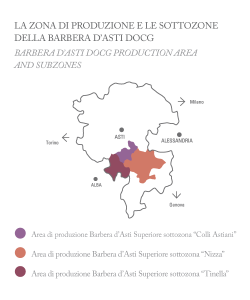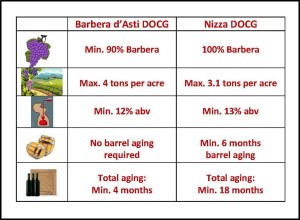Today we have a guest post from Mark Rashap, CWE…
It’s time for Nizza Barbera to take its rightful place in center stage!
Effective as of the 2014 harvest, the consortium that oversees wine laws for Asti and the Monferrato Hills in Piedmont promoted Nizza Monferrato and 18 surrounding villages (comuni) from a mere subzone of the Barbera d’Asti DOCG to a DOCG of their own: the autonomous Nizza DOCG. This promotion deserves particular attention from the wine community because it highlights the evolution of many European wine appellations, as well as Italy’s insistence to snub its nose at the EU’s DOP.
The most obvious marker of the Nizza DOCG is that all the grapes must be grown within a delineated geographic zone, which was already established, along with Tinella and Colli Astiani, as a subzone of Barbera d’Asti DOCG Superiore The new DOCG gets a bit particular, however, as every vineyard destined for the Nizza DOCG must be registered with the Consortium and tout particular soils and exposures. Vines must be entirely estate, planted on the slopes of hills facing south-east to south-west. The required density is at least 4,000 vines per hectare, and harvest must be done entirely by hand. This limits the total vineyard acreage of the DOCG to 250 ha (620 acres) – roughly the total area of Chateau Margaux.
In the winery, there are additional controls in place to ensure quality and to differentiate the Nizza DOCG from the greater Barbera d’Asti DOCG. Perhaps most importantly, Nizza must be 100% Barbera compared to the 90% for Barbera d’Asti. Yields are capped at 3.1 tons per acre, and there is a minimum ageing of 18 months (6 in barrel) before the wine is released to market. Finally, there is an organoleptic and laboratory analysis to make sure the finished wine has met the standards put forth by the Consortium. An interesting facet of this analysis that the minimum requirement of 26 g/L “dry extract.”
If you don’t place importance on minutiae, then the take-home is that Piedmont is dedicated to making some serious Barbera. Furthermore, it adds to the modern trend that “controlled” regions in Europe are tightening their quality standards, and promoting sub-regions to higher categories when – perhaps – their neighbors have suffered from over-production or unscrupulous producers. Other examples of this trend include Chianti Classico’s addition of the Gran Selezione category of quality, and the breakup of the Coteaux de Languedoc into individual AOC’s (blog post to come).
In the case of Nizza, if the year or producer’s bounty is not up to par, then the wine can be de-classified to Barbera d’Asti DOCG, Monferrato Rosso DOC, Piemonte Barbera DOC, or Piemonte Rosso DOC, thus allowing the image of Nizza to stay intact.
We also must be amused by Italy’s complete rejection of the EU’s Denominazione di Origene Protetta terminology because there is no means of distinguishing between the DOC and DOCG tiers. As we know, with the re-organization of the EU’s agricultural standards, it was left open for individual producer-countries the two systems of nomenclature. Italy was thus allowed to continue to apply for new DOCGs – as is apparent with Nizza – the newest, and the 74th. Perhaps…Tinella and Colli Astiani will be next?
For more information:
- Click here for the website of the consorzio
- Click here to download a copy of the Disciplinare-Nizza DOCG


Interesting and very informative piece, thanks!